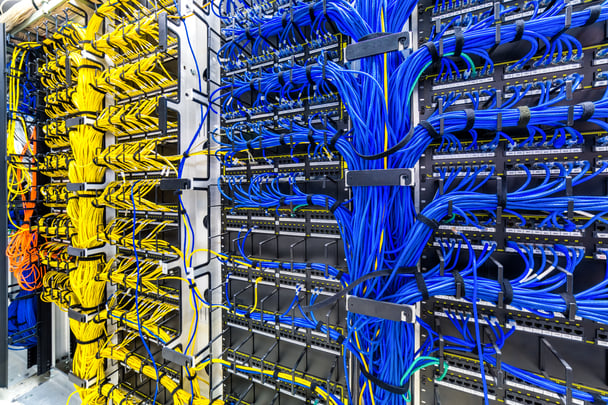Understanding complex cable connectivity is crucial to the overall installation and your project’s success
As seen in Data Center Dynamics.
Cable interconnectivity is vital for any data center network, with fiber optic cables as the media of choice.
With the ever-increasing demand for bandwidth and faster data transmissions, this media has become sophisticated. In today’s blog, we outline best practices and pitfalls to avoid when undertaking these complex installations.

Combining New Technologies
The ability to reach transmission speeds of 40, 100 and 400 Gigabits per second and beyond are the direct result of technological advancements, such as multi-fiber connectors (MPO / MTP), wavelength division multiplexing (WDM) and angled polished connectors (APC) for single-mode cables.
Most of these technologies have been on the market for years. However, today, many installations use a combination of these technologies to achieve the desired results. In today’s data centers, the cable design can have a critical impact on a new or existing data center. The following are everyday situations or challenges which can occur during data center builds or upgrades:
Incorrect network interface type used
- Selection of proper cable type
- Reversed polarity
- Mismatched connectors
- Installation practices
Incorrect Interface Type
The use of a wrong interface or module can happen for various reasons; the most common is a breakdown in communication between network engineers and data center equipment installers. The installed module does not conform to the required transmission standards. For example, the use of an Ethernet SFP module for Fiber Channel communications. With seemingly endless interface options available, it is critical that the cabling is compatible with the network design. There have been occasions when the network design effort lagged behind the data center build, resulting in incorrect media installations.
Using Proper Fiber Optic Cables
Once the network interfaces are determined, the connectivity media can be selected. Will the data center need single-mode, multi-mode, or a combination of the two cable types? Will these cables require MPO/MTP or LC type connectors? Ensuring the proper cables and connectors are in place between devices is crucial. An understanding of the network demands during the planning will alleviate potential incompatibilities.
Reversed Polarity
Determining the polarity of fiber optic cables has increased in complexity over the last decade due to the advent of MPO/MTP connectors and the ability to split and tap these optics. Careful consideration must be taken regarding selecting connector types (male (pinned) or female (non-pinned) connectors, key-up or key-down) and how they mate to multiple types of cassettes, devices, and other cables. Errors in the cable design or installation are both costly and time consuming to repair. Understanding which end of the fiber strand connection is transmitting or receiving data can be difficult, especially if it has multiple hops in a large data center.
Mismatched Connectors
If you have a fiber cable with an aqua MPO connector, does it work with that blue MPO cassette? Although these connectors mate, it does not mean that they will work. In addition to the multi-mode cable versus single-mode cassette issue, the single-mode connectors on the cassette can also be angled polished (known as APC) which adds another level of complexity to the already confusing cabling landscape.
Installation Practices
During installations in the field, common factors that contribute to issues include dirty conditions leading to dust on the fiber optics, as well as poor installation practices leading to micro-bends and fractures. Even a brand-new, factory-sealed cable should be cleaned before installation for optimal results. In some cases, multiple cleanings may be required to mitigate risk to the connections. Following proper installation procedures and having suitable pathways will reduce cable damage.
Conclusion
Taking these complexities into account, you must ask the right questions and effectively communicate network and design concepts. Understanding complex cable connectivity is crucial to the overall installation and your project’s success. It is critical to engage with a well-versed team familiar with these technologies to operate on the true cutting-edge of data center communications.
